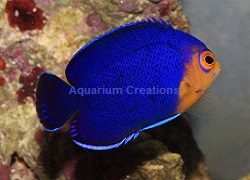Pygmy (Cherub) Angelfish
Centropyge argi, Caribbean

YouTube Video of Dwarf Pygmy Angel
Identification:
Dwarf Pygmy Angelfish are intelligent, active, and hardy as well. These are very pugnacious little fish,
so house the Cherub Pygmy Angelfish with more aggressive tank mates.
TankRecommendations:
Provide a 30 gallon or larger tank with large amounts of live rock for
hiding and grazing on micro fauna.
Food and diet:
Provide a balanced diet. Feed frozen foods from a wide range of food groups that
have both meat and algae (Formula One, Formula Two, Ocean Nutrition Pygmy Angel Formula are all good examples, algae and nori sheets as a good pellet food.
Level of Care:
Moderate
Acclimaton Time:
3+ hours
Reef Compatibility
: With Carution
Approximate Purchase Size:
1" to 2"
|
|

